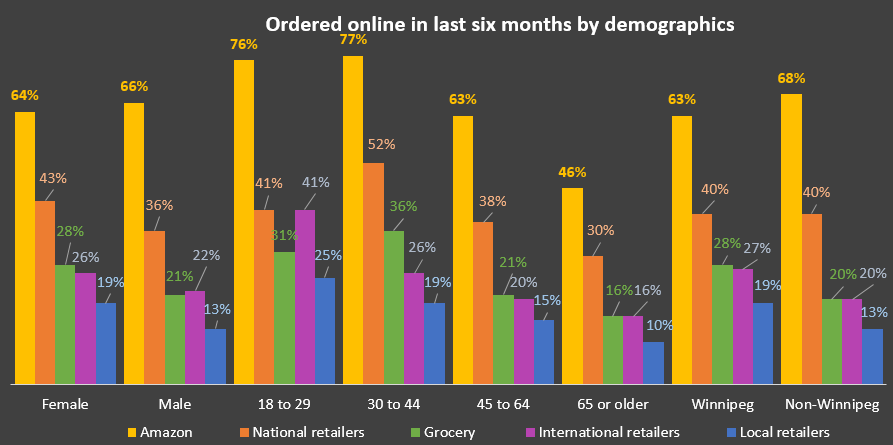Research |

Perceptions and perspectives from Manitobans about online Shopping (September 10, 2020)
September 10, 2020![]() Click here for a print friendly version of this report
Click here for a print friendly version of this report
During the pandemic, Manitobans have been shopping online
Perhaps not surprisingly, many Manitobans report that their online shopping has increased over the last six months. It appears as though the biggest online retailers are benefiting most from this increase.
Overall, 46% of Manitobans report that their household’s online shopping has increased over the last six months.
Women (49%) are slightly more likely than men (40%) to report that online purchases have increased, which may reflect that, for many households, women are more often responsible for shopping.
Those 65 and older are the least likely to report that their online shopping has increased in the last six months (32%), while those aged 30 to 44 are the most likely (55%). In addition, Winnipeggers (49%) are more likely than those living outside the city (39%) to report increases in online shopping in the last six months.

In the past six months, over 8 in 10 Manitobans report ordering online for pick-up or delivery, with orders from Amazon being the most common at 64% of Manitobans.
During the pandemic, the frequency of in-person shopping has been significantly reduced; however, few have turned to local retailers (17%), preferring national (40%) retailers (e.g., the Bay or Canadian Tire) or international (24%) retailers when making online purchases.

Online retailers by demographics
While the same proportion of women and men report ordering online from Amazon, women are consistently more likely than men to order from all other types of retailers.
Use of online shopping decreases with age, with 31% of those 65 years of age and older reporting that they did not order anything online in the last six months, but only 10% of those under 45 years of age reporting the same. Among the various age cohorts, those 30 to 44 years of age are the most likely to report having ordered from Amazon (77%), national retailers (52%), and grocery stores (36%). Those in the youngest age cohort (18 to 29) are the most likely to have ordered from international retailers (41%) and local retailers (25%).

Biggest increase among grocery stores and local retailers
As might be expected, those who increased their online shopping were more likely to report shopping at all types of online retailers when compared with those who report that their online shopping has stayed about the same or decreased.
However, the biggest differences between those who increased their online shopping and those who did not are found in shopping for groceries online, as those who increased their online shopping were three times more likely than those who did not to shop online for groceries, and shopping online with local retailers, as those who increased their online shopping were twice as likely as those who did not to shop online with a local retailer. This suggests that those who increased their online shopping made efforts to buy locally, while those who did not increase their online shopping simply continued to visit the same online sites they always had.

METHODOLOGY
PRA conducted the survey from August 27 – September 1, 2020, using its Manitoba Panel. In total, 1,846 Manitobans completed the survey.
Because this sample is a non-probability sample, no error rate can be calculated. A random population survey of this size would yield an error rate of ± 2.3% (19 times out of 20).
As any sample may not represent the population perfectly, PRA corrects statistically for discrepancies in gender, age, and income to ensure that the sample corresponds as closely as possible to Statistics Canada information.
PRA Inc. sponsored these questions independently.
No other organization, public or private, funded this study in whole or in part.
For more information about the research, please contact Nicholas Borodenko, partner, at borodenko@pra.ca
(204) 987-2030 or toll-free at 1-888-877-6744
Recent Posts

Manitobans Express Growing Concern Over Potential US Tariffs and Adjust Habits to Support Local Economy
February 12, 2025Authored by Zia HameedQuestions about the research can be directed to Nicholas Borodenko, borodenko@pra.ca Recently, the United States proposed to impose tariffs on Canada, initially set to be implemented on February 4, 2025. However, a temporary 30-day pause has been agreed upon. A recent survey conducted by PRA Inc. has revealed that Manitobans […]

Non-seatbelt use higher in rural Manitoba, while electronic communication device use higher in Winnipeg: Manitoba Public Insurance
A road safety observation study commissioned last fall by Manitoba Public Insurance reports that non-seatbelt use is higher in rural Manitoba with 10 per cent of all drivers observed not wearing their seatbelt, compared to three per cent in the Winnipeg capital region.
